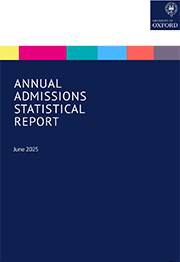
Undergraduate admissions statistics
Oxford University is pleased to publish its Annual Admissions Statistical Report. This gives information on the students who have applied to our undergraduate courses, received offers and been admitted, over the last five admissions years between 2020 and 2024.
The statistics are broken down by domicile, nation and region of the UK, disadvantage, school type, gender, ethnicity and disability, and they are presented at University level and by course and college. We publish this Report to measure our progress and provide transparency about our processes.
The data reveals the consolidation of our recent progress to ensure that those with the highest academic potential, from all backgrounds, can realise their aspirations to study here. In 2024, 3,245 students were admitted to Oxford to begin their undergraduate studies. The number of undergraduate students admitted from the UK increased slightly to 80.5%; of those, 8.1% were eligible for Free School Meals (up from 5.3% in 2021).
We remain committed over the long-term to ensuring that our undergraduate student body reflects the diversity of the UK and are building on and expanding our outreach activities to engage students earlier in their educational journey.
Between 2020 and 2024, within the total group of UK-domiciled undergraduates admitted:
- The proportion from state schools decreased slightly from a high point of 68.6% to 66.2%.
- The proportion identifying as Black and Minority Ethnic (BME) increased from 23.6% to 30.8%.
- The proportion from socio-economically disadvantaged areas, having fallen from a high of 16.0%, stabilised at 14.5%.
- The proportion from areas of low progression to higher education, having fallen from a high of 17.0%, stabilised at 13.6%.
- The proportion declaring a disability increased from 10.4% to 19.0%.
- The proportion of women decreased from 54.2% to 51.9%.
We remain committed to ensuring that talented, academically motivated students, from all backgrounds, see Oxford as a place for them and have a fair chance of securing an offer for their selected course.
If you are a student considering applying to Oxford, a family member, or teacher with ideas about how we can reach more young people across the UK, please get in touch via ox.ac.uk/ask, as we would love to hear your thoughts.
Information and advice about applying to Oxford and giving more detail on the student experience itself, including forthcoming events, is regularly posted on our Admissions pages.
Students and parents
- Please see: ox.ac.uk/study
- Events: ox.ac.uk/outreach
- Contact us: ox.ac.uk/ask
Teachers
- Resources and events: ox.ac.uk/teachers
- Regional outreach: ox.ac.uk/oxfordforUK
- Contact us: ox.ac.uk/ask
Journalists, MPs and others
- Contact us: [email protected], +44 (0)1865 280528.
